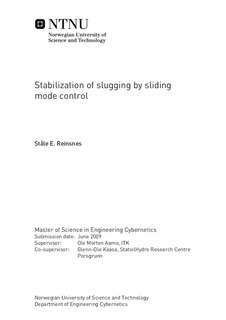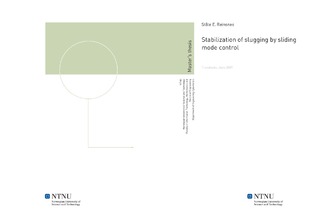| dc.description.abstract | The objective of this master thesis is to design, implement, and evaluate sliding mode control (SMC) applied to stabilize slugging using only the downhole pressure as measurement. The pros and cons of the resulting output-feedback sliding mode controller are to be evaluated against the conventional PI controller. The thesis is based on, and a continuation of the work and conclusions of my project thesis, where the conclusion was that the SMC might have a significant potential for increased oil production and recovery. The clear limitation was however the uncertainty regarding the validity of the van Der Pol model used, and the fact that the SMC was provided the real time-derivative states. Therefore the original main tasks of this thesis was to implement a high fidelity simulation model of severe riser slugging, and to design (and test) differentiators with the purpose of evaluating the output-feedback performance of the SMC. As it turn out that I was not able to achieve the task of stabilizing the pressure with SMC on the chosen OLGA model, the focus of this thesis has in agreement with my supervisors been changed quite a lot from the task requested in the project description. Possible reasons for the lack of results, and the chosen focus of the thesis is presented in the introduction chapter. The thereby chosen focus became the task of designing testing differentiators for the SMC, but with testing on the van Der Pol model. Before presenting and arguing for this change of focus in the section about task and limitation, the introduction chapter starts by giving a brief overview of the environment or setting the controlling challenge is a part of, and follows up by presenting the work and conclusion of that project thesis. In the end of the chapter, the structure of the thesis is shortly listed. The introduction is followed up by giving a further insight to the slug problematic. An overview of the historical development, and a description of some research within the field are provided. The last part of the chapter gives a quite thorough description on the riser slugging phenomenon. Thereby the sliding mode controller (SMC) is presented in chapter 3. The challenge concerning chattering is also discussed, and the approach of using boundary layer to suppress the chattering is introduced. In chapter 4, the empirical van der Pol based model is derived, and the model is augmented to use the valve rate as control input. Chapter 6 gives a discussion on why the SMC should be performed on the choke rate and not directly on the choke opening. This section also designs the SMC that will be used for testing, and the needed time-derivatives for testing the SMC are derived. The chosen main focus of this thesis is to evaluate if there is possible to design observers (differentiators) that meets the requirements for the designed SMC to stabilize slugging. The tests are performed on the van Der Pol model. This task is introduced through chapter 7, that present general observer theory, theory about using observers combined with SMC, and finally the two observers chosen for further testing; the high gain observer (HGO) and the robust high-order sliding mode differentiator (RHOSMD). The first stage in evaluating the HGO and RHOSMD is open loop testing, and is described in chapter 8. The observers perform well for the ideal case of no disturbance, but in the presence of measurement noise the conclusion is that estimations of the higher order time-derivatives do likely not meet the very demanding requirements of the SMC. The biggest problem is probably the time-delay of the estimation, but the correctness of the amplitude might also be a problem. In chapter 9 the observers was tested further in a SMC controlled closed loop system to get a more precise indication on how well the observers are fitted for their intended task of providing the SMC with the required estimations. As for the open loop tests, the 'isolated' estimation performance of the required states was considered, but the main focus was the performance of the output-feedback SMC compared to the performance of manual choking, the PI controller, and the performance of the state-feedback SMC. This chapter confirmed the assumption from the open loop testing that in presence of measurement noise, the observers is not able to meet the demanding requirements of the designed SMC. For the theoretical ideal case of no disturbance the results is very good, especially for the HGO. In the case of measurement noise, the RHOSMD perform slightly better. In both chapter 8 and 9, tuning is considered and discussed. However, since the conclusions of the observer testing is negative, the SMC is not tested further. The results will be negative for output-feedback testing, and a quite extensive state-feedback testing of the SMC is performed in the project thesis. The main results and conclusions throughout the thesis, are presented in chapter 10. The chapter also contain a short discussion where it is concluded that the alternative designs, SMC with direct choke rate control and SMC of the choke acceleration, will not be a solution on the state-feedback SMC problems described in this thesis. There is also a short discussion regarding CPU and system requirements for the observers and the controller. At the very end, further work is discussed. | nb_NO |

